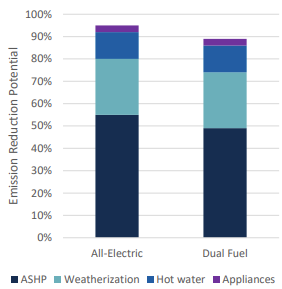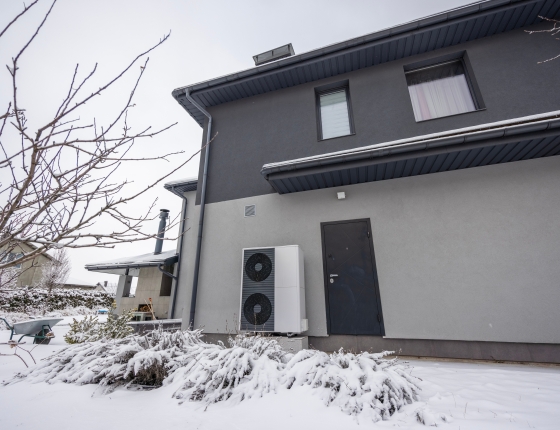CEE's Building Decarbonization Vision
Minnesota Statute establishes a greenhouse gas emission reduction goal of net-zero emissions economy-wide by 2050. As our electric utilities decarbonize the state’s electric system by 2040 thanks to the Carbon Free Standard passed in 2023, converting homes and businesses to efficient electric appliances while making them more efficient offers huge potential for progress on statewide goals. To illustrate this opportunity, CEE is launching a four-part blog series over the next two months laying out key components of our vision for decarbonizing the residential and commercial building stock in Minnesota.
Part One focuses on the importance of pursuing dual fuel applications while also fully electrifying buildings as much as possible. Part Two will focus on the capabilities and characteristics of efficient electric space heating technologies available today. Part Three will focus on the impact of electrifying space heating on the electric system. Part Four will bring together the preceding parts to illustrate CEE’s policy vision for Minnesota. While there are many important tools, technologies, and approaches to decarbonizing our state’s building stock, this series focuses on the critical components of home and building weatherization and electrification of space heating.
Part One: Embracing the dual fuel pathway
CEE’s vision is a healthy, carbon-neutral economy that works for all people. To further that vision, we have worked for decades to improve Minnesota’s building stock through research, programs, engagement, policy, and funding dedicated to making homes and businesses more efficient, using less energy and reducing emissions. As utilities decarbonize electricity generation and technology advances to make electric end uses more efficient and cost-effective, our vision encompasses a world where Minnesota’s homes and businesses are not only efficient but also predominantly powered by affordable, reliable, carbon-free, all-electric end uses.
Thanks to advances in technology, strong state policies, and thoughtful and pragmatic builders and contractors, building an efficient all-electric home is possible in a cold climate state like Minnesota — builders across the state are currently carrying out projects to that effect. CEE is a proud partner, supporter, and collaborator on many of these projects.
But while efficient all-electric homes and buildings are the vision, bringing that vision to scale across the state on the timeline needed to meet Minnesota’s 2050 emission reduction goals presents a monumental challenge, particularly for existing homes and buildings. That is why we must also embrace policies and applications that encompass a dual fuel approach, one in which portions of a home or building’s energy use are provided by efficient electric appliances like air source heat pumps, and other portions are provided by another source like natural gas.
We know that a combination of home and building efficiency programs, efficient space and water heating technologies, and fair and effective rate design can make all-electric and dual fuel applications affordable for individual customers without sacrificing comfort or safety in our cold climate state.
Thanks to existing research and analysis, we also know that dual fuel approaches can provide significant emission reduction benefits while mitigating costs at the utility system level, which saves money for all ratepayers.
G21 Report
In July 2021, CEE and the Great Plains Institute published the report Decarbonizing Minnesota’s Natural Gas End Uses, also called the G21 Report. That report was the culmination of 18 months of stakeholder meetings aimed at addressing challenges related to deep decarbonization of natural gas end uses in Minnesota. The process produced modeling done by E3 around three different decarbonization scenarios:
- High electrification in which almost all buildings switch to all-electric and are heated with air source heat pumps or ground source heat pumps, relying on electric resistance heating for backup.
- High electrification with gas backup in which buildings are heated primarily by heat pumps but keep their gas connection to use gas for backup heat during the coldest hours of the year.
- High decarbonized gas in which buildings continue to be heated primarily by gaseous fuels, with natural gas gradually replaced by a blend of biomethane, synthetic natural gas, and hydrogen.
In all scenarios, existing buildings achieve a high level of efficiency through retrofits, and remaining gas end uses under the high electrification and high electrification with gas backup scenarios were provided by biomethane, synthetic natural gas, or hydrogen.
While all three scenarios were modeled to achieve 100 percent decarbonization by 2050, the high electrification with gas backup scenario did so while avoiding the need for 8–9 GW of additional peak electric generation resources, saving nearly $2.5 billion in incremental electric system costs, and avoiding steeper future rate increases, compared to the high electrification/all-electric scenario.
City of Minneapolis Study
At a more localized scale, in February 2023 CEE published a study titled Minneapolis 1–4 Unit Residential Weatherization and Electrification Roadmap for the City of Minneapolis. The study developed a path for the City to achieve climate targets by modeling weatherization and electrification scenarios for Minneapolis’ 88,441 1–4 unit residential homes. Through that modeling, CEE assessed the impact of home weatherization and whole-house electrification retrofits of space heating, water heating, transportation, and other appliances on a variety of factors, including costs and emission reductions. 
CEE's analysis found 95 percent emission reductions from the full electrification and weatherization scenario, and 89 percent emission reductions from the scenario in which 80 percent of a home’s heating needs were provided by an efficient air source heat pump and 20 percent were provided by a gas furnace or boiler backup. Total emission reductions from stacking a heat pump, weatherization, all-electric hot water heater, and electrification of other appliances are shown in the chart pictured.
Similar to the G21 Report findings, these emission reductions from dual fuel applications come at lower system cost than converting homes to all-electric. The Minneapolis study found that full electrification with weatherization would quadruple peak load requirements for residential buildings compared to the status quo, but that dual fuel and load control strategies can be significant hedges against these issues. In addition, depending on a variety of factors such as the type of equipment installed and applicable utility rates, dual fuel applications can lead to lower operating costs for customers.
CEE is currently conducting a similar pathway study for Hennepin County and plans to share those results in early 2026.
The Quebec Approach
Lastly, an example from a similar cold climate region in the Canadian province of Quebec further highlights the importance of embracing dual fuel pathways. To meet the province’s climate goals, the electric utility Hydro-Quebec and gas utility Énergir jointly conducted a scenario analysis examining the emission reduction potential, cost impacts, and rate impacts of full electrification and a dual fuel approach. The results indicate that the dual fuel approach achieved significant emission reductions at a lower cost to customers of both utilities, as shown in the chart below. Notably, Hydro-Quebec avoided significant additional electric capacity from the dual fuel approach. We’ll discuss this issue further in Part Three of the series.

Quebec Scenario Analysis Results
As a result of this analysis, Hydro-Quebec and Énergir are collaboratively pushing installations of efficient electric space and water heating equipment to complement existing gas equipment in their overlapping service territories and offer customers a rate design that encourages optimal use of each fuel type. The Quebec model also includes a cost-sharing mechanism between Hydro-Quebec and Énergir that further mitigates cost impacts to customers. We’ll discuss these policy details further in Part Four.
You can see a more detailed description of the Quebec model on pages 11–23 of CEE’s reply comments in the PUC’s gas line extension docket.
While we aim to fully electrify significant portions of our state’s building stock, we can also achieve substantial emission reductions at a lower cost by embracing policies, programs, and efforts that advance dual fuel applications.
In Part Two, we’ll dive deeper into air source heat pump technology and performance, the importance of rate design, and the role of back-up resources at cold temperatures.
